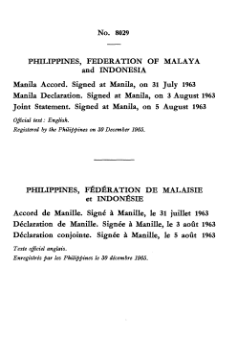الملايو الكبرى
| التشكل | July 1963 |
|---|---|
| النوع | International defence organisation |
الأعضاء |
اتحاد الملايو الكبرى Greater Malayan Confederation ،[1] أو مافيليندو Maphilindo (اختصار ماليزيا، والفلپين وإندونيسيا)، هو فكرة لإتحاد بلاد الملايو : " إندونيسيا, ماليزيا, بروناي, سنغافورة, الفلبين, تايلاند، كمبوديا " غالبية دول آسيان، بشخصية ملايو إسلامية في دولة واحدة.
خلفية
تمت محاولة الخطة الأصلية لدولة موحدة على أساس مفهوم عرق الملايو من قبل ونسسلاو ڤينزونس أثناء عصر الكومنولث في الفلپين. كان فينزونز قد تصور اتحاد عرق الملايو، في ما أسماه التحرير الوحدوي للملايو Malaya Irredenta (وهو اسم آخر لاحق للاتحاد). وفي كتابه الصادر سنة 1959 Someday, Malaysia, Major Eduardo Abdul Latif Martelino (later operations officer in the infamous Jabidah massacre) also cited the vision of then-President of the Philippines Manuel L. Quezon for integrated, pan-Malayan nationhood in the region. The president envisioned creating a better state which was united. Having a united race at the time would pave way for the development of the Malay. The united state would however, be achieved by the contribution of the people living in the region. The president was determined to make his intensions known to the people so that the vision could be easily achieved in the future.[2]
التاريخ
 الرئيس الفلپيني ديوسدادو مكاپاگال، اقترح خلق "مافيليندو". |
Maphilindo was initially proposed as a realization of Filipino national hero Dr. José Rizal's dream of uniting the Malay peoples, seen as artificially divided by colonial frontiers. Uniting the Malay people was highly prioritized resulting in many events occurring within the region. Dr. José Rizal significantly contributed to creating and officiating events designed to unite the people. In July 1963, Quezon's later successor, President Diosdado Macapagal, convened a summit in Manila where the three countries signed a series of agreements to resolve controversies over the former British colonies of North Borneo and Sarawak joining Malaysia. The treaties paved way for new developments in the region which would later contribute to the development of the country to what it is now.[3]
The union was described as a regional association that would approach issues of common concern.
The union was dismantled a month later[4] when Sukarno, President of Indonesia, adopted a policy of Konfrontasi (Indonesian, "confrontation") with the newly constituted Malaysia. The Konfrontasi aimed to prevent Malaysia from achieving full sovereignty and was introduced to President Sukarno by the Communist Party of Indonesia or PKI. The PKI had convinced President Sukarno that the formation of Malaysia was a form of neo-colonization that will later affect Indonesian stability.
انظر أيضاً
- Malayness
- Malay world
- أرخبيل الملايو
- جزر الهند الشرقية
- Malay race
- Nusantara
- إندونيسيا الكبرى
- الفلپين الكبرى
الهامش
- ^ "Archived copy" (PDF). Archived from the original (PDF) on 13 أكتوبر 2014. Retrieved 15 يناير 2016.
{{cite web}}: CS1 maint: archived copy as title (link) - ^ Sussman, Gerald (1983). "Macapagal, the Sabah Claim and Maphilindo: The politics of penetration". Journal of Contemporary Asia: 210–228. doi:10.1080/00472338380000141. Retrieved 1 December 2019.
{{cite journal}}: Cite journal requires|journal=(help) - ^ de Viana, Augusto V. (2017). "THE DREAM OF MALAYAN UNITY: PRESIDENT DIOSDADO MACAPAGAL AND THE MAPHILINDO". SEJARAH: Journal of the Department of History. Retrieved 1 December 2019.
{{cite journal}}: Cite journal requires|journal=(help) - ^ Weatherbee, Donald E.; Ralf Emmers; Mari Pangestu; Leonard C. Sebastian (2005). International relations in Southeast Asia. Rowman & Littlefield. pp. 68–69. ISBN 0-7425-2842-1. Retrieved 29 May 2009.

